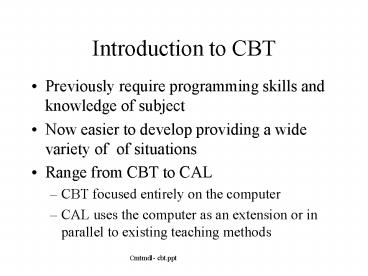Introduction to CBT - PowerPoint PPT Presentation
1 / 17
Title:
Introduction to CBT
Description:
Process for designing training i.e CBT, WBT. The process. comprehensive needs analysis ... Poorly designed or implemented CBT. Access to an appropriate computer, ... – PowerPoint PPT presentation
Number of Views:382
Avg rating:3.0/5.0
Title: Introduction to CBT
1
Introduction to CBT
- Previously require programming skills and
knowledge of subject - Now easier to develop providing a wide variety of
of situations - Range from CBT to CAL
- CBT focused entirely on the computer
- CAL uses the computer as an extension or in
parallel to existing teaching methods
2
Instructional Systems Design Process for
designing training i.e CBT, WBT
- The process
- comprehensive needs analysis
- user analysis
- design document (flowcharts, storyboards,evaluatio
n) - application prototype
- usability testing
- effectiveness evaluation
3
Models of Instruction
- Generally includes 4 phases
- Presenting (instructor centred)
- instructor presents information to student
- Guiding (more interactive)
- instructor guides student towards understanding
- Practising (student centred)
- student practices in order to retain it
- Assessing
- student demonstrates understanding (i.e. test)
4
Instructional methodologies
- Five major types
- Each provide one or more of the 4 phases
- Tutorials (provide first 2 phases)
- Drills (provide 3rd phase)
- Simulations (may include all phases)
- Games (provide 3rd phase)
- Tests (provide 1st and 4th phases)
5
Tutorials
- Appropriate for presenting factual information,
learning rules or principles, learning problem
solving strategies (used to provide first two
phases) - Information is presented to the student
- The student is questioned about the information
- A response is requested
- The response is judged or evaluated
- Feedback or mediation is given
6
General structure of tutorial
Present information
Question and response
Introductory section
Feedback or remedial response
Judge response
Closing
7
Drills
- Used primarily for practising
- Particularly important when learning information
in which fluency is required - i.e. basic skills, foreign languages, spelling,
usage and vocabulary
8
General structure of Drills
Select item
Question and response
Introductory section
Closing
Judge response
Feedback
9
Simulations
- Learns by performing activities similar to real
world (used for any of the four phases) - Useful when learning to use complicated,
difficult to obtain, expensive machines or pieces
of equipment, also better for dangerous
activities - Advantages are they increase motivation, safe,
convenient, controllable, cost, time, and are
repeatable.
10
General structure of Simulation and Games
Present scenario
Action required
Introductory section
Closing
Student acts
System updates
11
Games
- Purpose of both simulations and games is to
provide an environment that facilitates learning
or acquisition of skills. - Games however may or may not mimic reality.
- Advantage - fun to use, and if student is
learning at the same time lessons are well learned
12
Tests
- Designed to do two things
- quiz students on their knowledge of the material
- let them know which questions were missed and
what the correct answers were (can see score
immediately).
13
Benefits
- Can be taken at any time
- It can be taken anywhere
- Reduced learning time
- Educational consistency
- Refresher training
- Job-aid component
- Learner retention
- Effective use of resources
- No pressure
- No favouritism
- Cheaper
- More effective
14
Disadvantages
- Poorly designed or implemented CBT
- Access to an appropriate computer, and possibly
the Internet - Level of computer literacy - resistance
- Isolation
- Unrealistic expectations - can try different
responses without penalty - may not understand
underlying concepts - Confusion or boredom - poor system layout
- Possible rigidity - adaptability to individual
needs
15
Development Procedure
- Outline the content of the course
- Lay out a map of the CBT
- Write a treatment of the course
- Select learner activites
- Story-board how it will look
- Produce and multimedia effects
- Author CBT
- Evaluate course
16
CBT Authoring Tools
- In excess of 200 development tools
- Top four
- Authorware
- Icon Author
- Quest
- Toolbook
- All mature versions aimed at the serious
applications developer
17
The future
- Artificial Intelligence allows more flexible and
adaptable CBT to be developed which can more
accurately assess and address the needs of the
student - With the advent of Java distribution is far
easier and accessible - web provides an independent platform






























